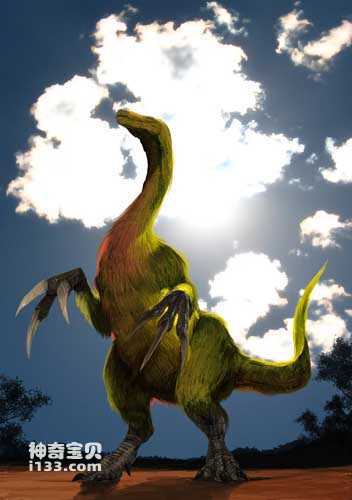Chinese name: Therizinosaurus
Latin name: Therizinosaurus
Age of survival: Late Cretaceous
Fossil origin: Mongolia, Kazakhstan
Physical characteristics: 8 to 11 meters long
Food habits: Omnivorous
Type: Theropod
Definition: scythe-handled lizard

In 1923, paleontologists discovered a huge fossil forearm skeleton and some fossil hook claws in Mongolia. Its forearm bones are up to 2.5 meters long, and some hooks are about 75 centimeters long - like a long-handled scythe used to weed weeds. Therefore, the discoverer named it "Turtle-shaped Therizinosaurus" and classified it as a giant turtle at that time. It was not until 1990, after more complete fossils were discovered, that Therizinosaurus was an unknown and huge dinosaur.
Therizinosaurus has a very strange appearance: its small head looks like a herbivorous animal, but its forelimbs with huge claws look like ferocious carnivorous animals. Its belly is bloated and fat, it walks slowly, and its feet are Wide and short, it can be called the "four unlikeliest" in the world of dinosaurs.
The strange-looking Therizinosaurus was a large theropod dinosaur that walked on two legs. It lived in the Gobi Desert of Mongolia during the Late Cretaceous (of course, the Gobi Desert at that time was not as desolate and full of yellow sand as it is today. It is a land with flourishing plants and abundant water and grass). Therizinosaur's tail was short and stiff because of the support called a bony rod on its tailbone. Judging from the skeletal structure of Therizinosaurus, it is more evolved than other Therizinosaur dinosaurs. Its type species is 9.6 meters long and weighs 6.2 tons. It has very long forelimbs with sharp claws on its fingers, as well as thick lower limbs and wide toes. It also had claws, a short tail, and was probably covered in primitive feathers. As for the way Therizinosaurus walked, some paleontologists believe that Therizinosaurus's forelimbs and hind limbs were similar in length, and it was estimated that it moved like a gorilla or a clawed beast. But more paleontologists believe that it should not have been on all fours because the structure of its forelimbs was not suitable for supporting its weight and its claws were in the way.
Since the skeletal fossils of Therizinosaurus are not complete, many of its features are at the stage of speculation and remain to be further developed and excavated.
animal tags: Therizinosaurus
We created this article in conjunction with AI technology, then made sure it was fact-checked and edited by a Animals Top editor.